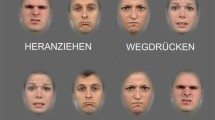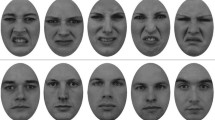Abstract
The contention that basic behavioral intentions are forecasted by emotional expressions has received surprisingly little empirical support. We introduce a behavioral task that gauges the speed with which movement of angry and fearful faces (toward or away from an expressor's gaze) are accurately detected. In two studies we found that perceivers were faster to correctly detect approaching anger faces (i.e., faces that moved in the direction of their own gaze). The opposite, however, was not true for fear expressions. These findings offer evidence that, at least for anger displays, the basic behavioral intent to approach is strongly transmitted and at very low-levels of processing, even priming congruent behavioral responses in observers. The null results for fear faces may indicate that these signal a “freezing” response or behavioral inhibition rather than flight per se. The results of this work are discussed in relation to contemporary theories of emotion.



Similar content being viewed by others
References
Adams, R. B., Jr., Hess, U., Kleck, R. E., & Wallbott, H. (2004). The influence of perceived gender on the perception of emotional dispositions. In A. Kappas (Ed.), Proceedings of the XIth Conference of the International Society for Research on Emotions, 16–20 August 2000, Quebec City (pp. 17–19). Amsterdam: ISRE publications/University of Amsterdam.
Adams, R., B., Jr., & Kleck, R. E. (2003). Perceived gaze direction and the processing of facial displays of emotion. Psychological Science, 14, 644–647.
Adams, R. B., Jr., & Kleck, R. E. (2005). The effects of direct and averted gaze on the perception of facially communicated emotion. Emotion, 5, 3–11.
Andrew, R. J. (1965). The origins of facial expressions. Scientific American, 213, 88–94.
Argyle, M., & Cook, M. (1976). Gaze and mutual gaze. New York, NY: Cambridge University Press.
Arnett, P. A., & Newman, J. P. (2000). Gray's three-arousal model: An empirical investigation. Personality and Individual Differences, 28, 1171–1189.
Baenninger, R. (1974). Some consequences of aggressive behavior: A selective review of the literature on other animals. Aggressive Behavior, 1, 17–37.
Baron-Cohen, S. (1995). Theory of mind and face-processing: How do they interact in development and psychopathology ? New York, NY: John Wiley & Sons.
Beaupre´, M., & Hess, U. (in press). Cross-cultural emotion recognition among Canadian ethnic groups. Journal of Cross-Cultural Psychology.
Cacioppo, J. T., Priester, J. R., & Berntson, G. G. (1993). Rudimentary determinants of attitudes: II. Arm flexion and extension have different effects on attitudes. Journal of Personality and Social Psychology, 65, 5–17.
Carver, C. S., & White, T. L. (1994). Behavioral inhibition, behavioral activation, and affective responses to impending reward and punishment: The BIS/BAS Scales. Journal of Personality and Social Psychology, 67, 319–333.
Chiao, J., & Ambady, N. (2001). [Emotional Expressions in White, Black and Asian Faces]. Unpublished set of photographs.
Darwin, C. (1872/1997). The expression of the emotions in man and animals. New York, NY: Oxford University Press.
Driver, J., Davis, G., Ricciardelli, P., Kidd, P., Maxwell, E., & Baron-Cohen, S. (1999). Gaze perception triggers reflexive visuospatial orienting. Visual Cognition, 6, 509–540.
Davidson, R. J. (1992). Emotion and affective style. Psychological Science, 3, 39–43.
Davidson, R. J. (1993). Parsing affective space: Perspectives from neuropsychology and psychophysiology. Neuropsychology, 7, 464–475.
Davidson, R. J. (1998). Affective style and affective disorders: Perspectives from affective neuroscience. Cognition and Emotion, 12, 307–330.
Davidson, R. J., & Hugdahl, K. (Eds.) (1995). Brain asymmetry. Cambridge, MA: Mit Press.
Ekman, P. (1972). Universals and cultural differences in facial expressions of emotion. In J. Cole (Ed.), Nebraska symposium on motivation (Vol. 19, pp. 207–283). Lincoln: University of Nebraska Press.
Ekman, P. (1973). Darwin and facial expression: A century of research in review. New York: Academic Press.
Ekman, P. (1997). Should we call it expression or communication? Innovations in Social Science Research, 10, 333–344.
Ekman, P., Friesen, W. V., O’Sullivan, M., Chan, A., Diacoyanni-Tarlatzis, I., Heider, K., et al. (1987). Universals and cultural differences in the judgments of facial expressions of emotion. Journal of Personality and Social Psychology, 53, 712–717.
Fridlund, A. J. (1994). Human facial expression: An evolutionary view. San Diego, CA: Academic Press.
Frijda, N. H. (1995). Expression, emotion, neither, or both? Cognition and Emotion, 9, 617–635.
Frijda, N. H., & Tcherkassof, A. (1997). Facial expressions as modes of action readiness. In J. A. Russell & J. M. Ferna´ndez-Dols (Eds.), The psychology of facial expression (pp. 78–103). Cambridge, England and Paris: Cambridge University Press & Editions de la Maison des Sciences de l’Homme.
Gray, J. A. (1987). The neuropsychology of emotion and personality. S. H. M. van Goozen, & N. E. Van de Poll (Eds.), Cognitive neurochemistry (pp. 171–190). Oxford University Press.
Gray, J. A. (1994). Framework for a taxonomy of psychiatric disorder. In v. G. S. H. M. Ed & V. d. P. N. E. Ed (Eds.), Emotions: Essays on emotion theory (pp. 29–59). Lawrence Erlbaum.
Harmon-Jones, E. (2003). Clarifying the emotive functions of asymmetrical frontal cortical activity. Psychophysiology, 40, 838–848.
Harmon-Jones, E. (2004). Anger and behavioral approach system. Personality and Individual Differences, 35, 995–1005.
Harmon-Jones, E., & Allen, J. J. B. (1998). Anger and frontal brain activity: EEG asymmetry consistent with approach motivation despite negative affective valence. Journal of Personality and Social Psychology, 74, 1310–1316.
Harmon-Jones, E., & Segilman, J. (2001). State anger and prefrontal brain activity: Evidence that insult-related relative left-prefrontal activation is associated with experienced anger and aggression. Journal of Personality and Social Psychology, 80, 797–803.
Haxby, J. V., Parasuraman, R., Lalonde, F., & Abboud, H. (1993). SuperLab: General-purpose Macintosh software for human experimental psychology and psychological testing. Behavior Research Methods, Instruments, and Computers, 25, 400–405.
Hess, U., Adams, R. B., Jr., & Kleck, R. E. (2004). Dominance, gender and emotion expression. Emotion, 4, 378–388.
Hess, U., Adams, R. B., Jr., & Kleck, R. E., (in press). When two do the same it might not mean the same: The perception of emotional expressions shown by men and women. In U. Hess & P. Philippot (Eds.), Group Dynamics and Emotional Expression. New York: Cambridge University Press.
Hess, U., Sylvie, B., & Kleck, R. E. (2000). The influence of facial emotion displays, gender, and ethnicity on judgments of dominance and affiliation. Journal of Nonverbal Behavior, 24, 265–283.
Horstmann, G. (2003). What do facial expressions convey: Feeling states, behavioral intentions, or action requests? Emotion, 3, 150–166.
Izard, C. E. (1971). The face of emotion. New York, NY: Appleton-Century-Crofts.
Knutson, B. (1996). Facial expressions of emotion influence interpersonal trait inferences. Journal of Nonverbal Behavior, 20, 165–182.
LeDoux, J. E. (1996). The emotional brain: The mysterious underpinnings of emotional life. New York: Simon & Schuster.
Marsh, A. A., Adams, R. B., Jr., & Kleck, R. E. (2005). Why do fear and anger look the way they do? Form and social function in facial expressions. Personality and Social Psychological Bulletin, 31, 73–86.
Marsh, A. A., Ambady, N., & Kleck, R. E. (2005). The effects of fear and anger facial expressions on approach- and avoidance-related behaviors. Emotion, 5, 119–124.
Matthys, W., van Goozen, S. H. M., de Vries, H., Cohen-Kettenis, P. T., & van Engeland, H. (1998). The dominance of behavioural activation over behavioural inhibition in conduct disordered boys with or without attention deficit hyperactivity disorder. Journal of Child Psychology and Psychiatry and Allied Disciplines, 39, 643–651.
Miller, N. E. (1937). Analysis of the form of conflict reactions. Psychological Bulletin, 34, 720.
Neumann, R., & Strack, F. (2000). Approach and avoidance: The influence of proprioceptive and exteroceptive cues on encoding of affective information. Journal of Personality and Social Psychology, 79, 39–48.
Niedenthal, P. M., Barsalou, L. W., Winkielman, P., Krauth-Gruber, S., & Ric, F. (2005). Embodiment in attitudes, social perception, and emotion. Personality and Social Psychology Review, 9, 184–211.
Potegal, M. (1979). The reinforcing value of several types of aggressive behavior: A review. Aggressive Behavior, 353–373.
Russell, J. A. (1997). The psychology of facial expression. New York, NY: Cambridge University Press.
Russell, J. A. (1980). A circumplex model of affect. Journal of Personality and Social Psychology, 39, 1161–1178.
Schmidt, L. A. (1999). Frontal brain electrical activity in shyness and sociability. Psychological Science, 10, 316–320.
Sutton, S. K., & Davidson, R. J. (1997). Prefrontal brain asymmetry: A biological substrate of the behavioral approach and inhibition systems. Psychological Science, 8, 204–210.
van Hoof, J. A. R. A. M. (1976). The comparison of facial expression in man and higher primates. In M. von Cranach (Ed.), Methods of Inference From Animal to Human Behavior (pp. 165–169). Chicago, IL: Aldine.
Watson, D., & Tellegmen, A. (1985). Toward a consensual model of mood. Psychological Bulletin, 98, 219–235.
Watson, D., Wiese, D., Vaidya, J., & Tellegen, A. (1999). The two general activation systems of affect: Structural findings, evolutionary considerations, and psychobiological evidence. Journal of Personality and Social Psychology, 76, 820–838.
Yik, M. S. M., & Russell, J. A. (1999). Interpretation of faces: A cross-cultural study of a prediction from Fridlund's theory. Cognition and Emotion, 13, 93–104.
Author information
Authors and Affiliations
Corresponding author
Rights and permissions
About this article
Cite this article
Adams, R.B., Ambady, N., Macrae, C.N. et al. Emotional expressions forecast approach-avoidance behavior. Motiv Emot 30, 177–186 (2006). https://doi.org/10.1007/s11031-006-9020-2
Received:
Accepted:
Published:
Issue Date:
DOI: https://doi.org/10.1007/s11031-006-9020-2




